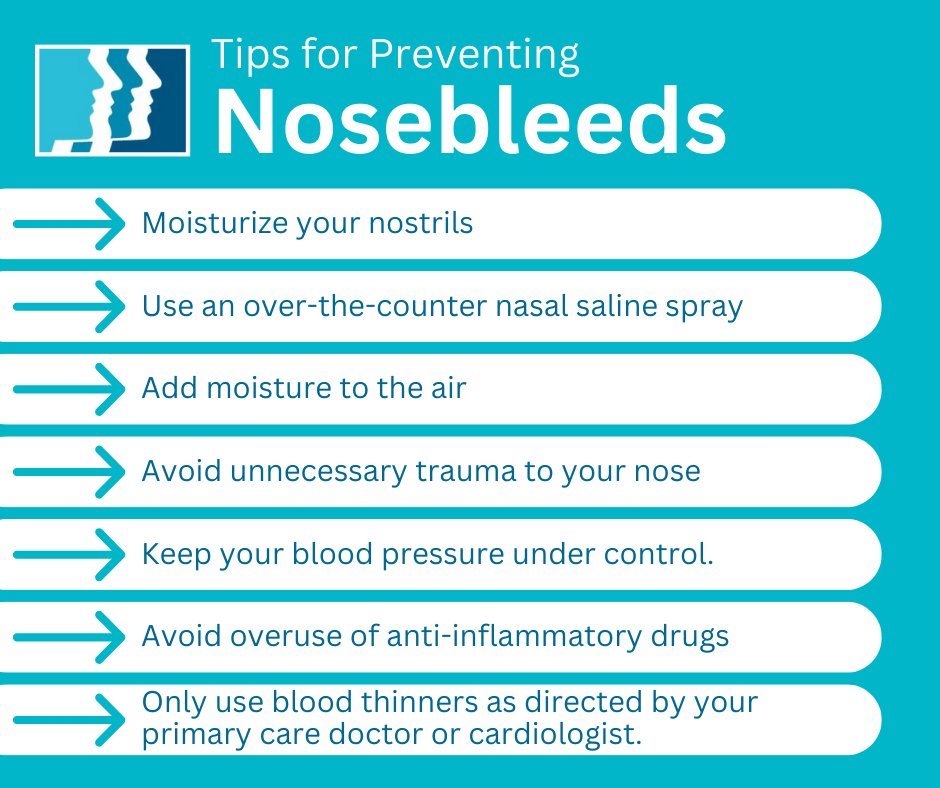3 Types of Nose Cautery for Epistaxis Explained

If you (or your child) have ever experienced a nosebleed, you know they’re no fun — and can even be frightening.
About 60% of people have experienced a nosebleed (also called epistaxis), but only 10% of those are severe enough to warrant medical intervention, such as cauterization.
It may sound surprising to think of having your nose cauterized. But nose cautery can be an excellent solution and may prevent recurrent nosebleeds.
If you’re looking for relief from frequent or severe nosebleeds, here are three ways an ENT might use nose cautery to treat them.
What Are the Different Types of Nosebleeds?
There are two types of nosebleeds:
- Anterior nosebleeds are located towards the front of the nose. These are more common, and we usually treat them in-office with silver nitrate, a chemical that doctors have used for hundreds of years. Silver nitrate binds to the tissues inside your nose, effectively cauterizing the blood vessels to stop blood flow and, therefore, the nosebleed. There may be a little bleeding following the procedure, but nothing to worry about. In some cases, additional treatment may be necessary in the future.
- Posterior nosebleeds are located farther back in the nasal passage, near the throat. These are far less common, making up perhaps five to 10% of cases, but they are more severe, sometimes even life-threatening. Doctors typically treat this type of nosebleed in an emergency room with a balloon catheter, which must remain in the nose for two to three days.
But suppose the balloon catheter doesn’t stop a posterior nosebleed. What then?
In that case, doctors may need to employ a more complex procedure called embolization, which involves entering your blood vessel network through your groin and blocking off the vessels that feed the back of your nose.
Another possible way to have your nose cauterized is with bipolar electrocautery. This minimally invasive in-office procedure uses an electric current to cauterize the inside of your nose, sealing the blood vessels and building scar tissue to prevent more bleeding. It sounds scary, but don’t worry! We numb the inside of your nose first, so you don’t feel a thing.
How to Care for Your Nose After Cauterization
Caring for your nose after having it cauterized is relatively easy. All you have to do is apply a nasal saline spray or gel to the affected area and moisturize your nostrils with Vaseline as needed.

Tips for Preventing Nosebleeds
To prevent nosebleeds in the first place, try implementing these helpful tips:
- Moisturize your nostrils with an ointment like Vaseline, Bacitracin, or Bactroban. Use it twice daily to prevent dryness and reduce the risk of infection.
- Use an over-the-counter nasal saline spray every four to six hours to moisten your nose.
- Add moisture to the air by using a humidifier when you sleep.
- Avoid unnecessary trauma to your nose by not rubbing or picking excessively. Keep your fingernails trimmed to avoid accidentally cutting the inside of your nose.
- Keep your blood pressure under control. High blood pressure may increase your risk of severe nosebleeds. One study found that people with high blood pressure are 2.7 times more likely to require emergency care for nosebleeds than those with healthy blood pressure.
- Avoid overuse of anti-inflammatory drugs like ibuprofen and aspirin and excessive consumption of fish oils. Too much can cause nosebleeds.
- Only use blood thinners as your primary care physician or cardiologist has prescribed. If you take blood thinners, you may have worse nosebleeds than those who don’t.
How to Treat a Nosebleed at Home
If you get a nosebleed, you don’t necessarily need to drop everything and run to the doctor’s office to have your nose cauterized. Most often, you can treat nosebleeds at home.
Try these steps before getting medical care from a professional:
- Extend your head and lean forward (not back, like you see on TV).
- Use Afrin (oxymetazoline) or phenylephrine nasal sprays to help slow the nosebleed. Spray the medication directly into your nose, or moisten a cotton ball and insert it into the nostril that’s bleeding.
- Use your fingers or a nasal clamp to apply pressure to the soft part of your nose right above your nostrils. Hold the pressure for five minutes. Although it’s tempting, don’t let go to see if the bleeding has stopped.
- If the bleeding continues after five minutes, spray more Afrin into your nose and apply pressure again for 10 more minutes.
- If the bleeding continues, it’s time to head to the ER for treatment, where you may need to have your nose cauterized.
Dr. Cuthbertson is a physician at Ear Nose & Throat Associates of Lubbock. He joined the team at ENT Lubbock from Houston, where he was chief resident of the prestigious Bobby R. Alford Department of Otolaryngology at Baylor College of Medicine. He is board certified in Otolaryngology and Head & Neck Surgery and has quickly built a reputation, not only as an extremely skilled surgeon, but as an approachable and compassionate clinician adept in the newest standards and technologies. Learn more about Dr. Cuthbertson.
Categories:








